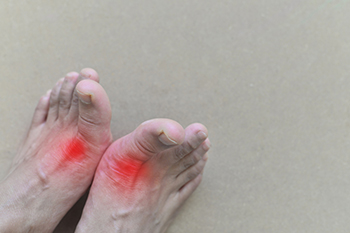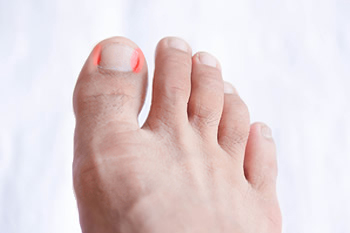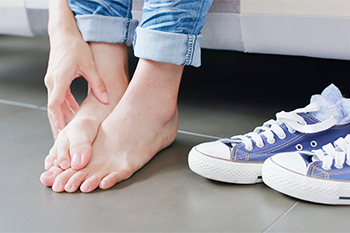Items filtered by date: June 2025
Understanding the Causes and Symptoms of Gout

Gout is a painful form of inflammatory arthritis caused by a buildup of uric acid crystals in the joints, most commonly the big toe. This condition can develop suddenly and is often triggered by dietary choices, genetics, or underlying health issues. Risk factors include cardiovascular disease, diabetes, diuretic use, obesity, and elevated triglyceride levels. Symptoms of gout include intense joint pain, redness, swelling, and warmth, often described as feeling like the toe is on fire. The joint may become so tender that even the weight of a bedsheet feels unbearable. A podiatrist plays a vital role in diagnosing and managing gout. Through physical examination, imaging, and lab tests, they can confirm the condition and offer relief through medication, dietary guidance, and preventive strategies to manage flare-ups and avoid joint damage. If you are dealing with this condition, it is suggested you make an appointment with a podiatrist for evaluation and treatment.
Gout is a foot condition that requires certain treatment and care. If you are seeking treatment, contact Lauryn Smith-Winton, DPM from S.W. Podiatry Group. Our doctor will treat your foot and ankle needs.
What Is Gout?
Gout is a type of arthritis caused by a buildup of uric acid in the bloodstream. It often develops in the foot, especially the big toe area, although it can manifest in other parts of the body as well. Gout can make walking and standing very painful and is especially common in diabetics and the obese.
People typically get gout because of a poor diet. Genetic predisposition is also a factor. The children of parents who have had gout frequently have a chance of developing it themselves.
Gout can easily be identified by redness and inflammation of the big toe and the surrounding areas of the foot. Other symptoms include extreme fatigue, joint pain, and running high fevers. Sometimes corticosteroid drugs can be prescribed to treat gout, but the best way to combat this disease is to get more exercise and eat a better diet.
If you have any questions, please feel free to contact our office located in Waldorf, MD . We offer the newest diagnostic and treatment technologies for all your foot care needs.
Categories of Ingrown Toenails

Ingrown toenails are typically classified based on severity and depth of nail penetration into the surrounding skin. A mild ingrown toenail involves redness, swelling, and slight tenderness where the nail edge presses against the skin. A moderate ingrown toenail may cause increased pain, drainage, and signs of infection as the nail begins to pierce the skin. A severe ingrown toenail often includes significant inflammation, pus, overgrowth of tissue, and difficulty walking due to intense discomfort. Chronic cases may result in repeated infections or thickened skin. Each stage may require a different approach to care, from at-home soaking and nail trimming to professional treatment such as partial nail removal. If you are experiencing persistent or painful symptoms, it is suggested that you see a podiatrist for a diagnosis and treatment to prevent further complications and restore comfort.
Ingrown toenails may initially present themselves as a minor discomfort, but they may progress into an infection in the skin without proper treatment. For more information about ingrown toenails, contact Lauryn Smith-Winton, DPM of S.W. Podiatry Group. Our doctor can provide the care you need to keep you pain-free and on your feet.
Ingrown Toenails
Ingrown toenails are caused when the corner or side of a toenail grows into the soft flesh surrounding it. They often result in redness, swelling, pain, and in some cases, infection. This condition typically affects the big toe and may recur if it is not treated properly.
Causes
- Improper toenail trimming
- Genetics
- Improper shoe fitting
- Injury from pedicures or nail picking
- Abnormal gait
- Poor hygiene
You are more likely to develop an ingrown toenail if you are obese, have diabetes, arthritis, or have any fungal infection in your nails. Additionally, people who have foot or toe deformities are at a higher risk of developing an ingrown toenail.
Symptoms
Some symptoms of ingrown toenails are redness, swelling, and pain. In rare cases, there may be a yellowish drainage coming from the nail.
Treatment
Ignoring an ingrown toenail can have serious complications. Infections of the nail border can progress to a deeper soft-tissue infection, which can then turn into a bone infection. You should always speak with your podiatrist if you suspect you have an ingrown toenail, especially if you have diabetes or poor circulation.
If you have any questions, please feel free to contact our office located in Waldorf, MD . We offer the newest diagnostic and treatment technologies for all your foot care needs.
Keep Your Feet Healthy So You Can Stay Active
Causes and Complications of Athlete’s Foot

Athlete’s foot is a fungal infection that affects the skin of the feet, especially between the toes. Athlete’s foot is caused by a fungus that thrives in warm, damp environments, such as inside tight shoes or sweaty socks. Plastic shoes, which trap heat and moisture, often make the condition worse. Athlete’s foot can spread through direct contact with infected skin or indirectly through shared surfaces like showers, pool decks, socks, or shoes. The infection typically causes itching, stinging, redness, peeling, and cracking of the skin. In more advanced cases, blisters, oozing, and swelling may develop. If untreated, the infection can spread to the toenails, making them thick, discolored, and difficult to trim. A podiatrist can help diagnose the infection, recommend appropriate medication, and monitor foot health for any complications. If you have developed a problematic athlete's foot infection, it is suggested that you schedule an appointment with a podiatrist for an exam and appropriate treatment options.
Athlete’s foot is an inconvenient condition that can be easily reduced with the proper treatment. If you have any concerns about your feet and ankles, contact Lauryn Smith-Winton, DPM from S.W. Podiatry Group. Our doctor will treat your foot and ankle needs.
Athlete’s Foot: The Sole Story
Athlete's foot, also known as tinea pedis, can be an extremely contagious foot infection. It is commonly contracted in public changing areas and bathrooms, dormitory style living quarters, around locker rooms and public swimming pools, or anywhere your feet often come into contact with other people.
Solutions to Combat Athlete’s Foot
- Hydrate your feet by using lotion
- Exfoliate
- Buff off nails
- Use of anti-fungal products
- Examine your feet and visit your doctor if any suspicious blisters or cuts develop
Athlete’s foot can cause many irritating symptoms such as dry and flaking skin, itching, and redness. Some more severe symptoms can include bleeding and cracked skin, intense itching and burning, and even pain when walking. In the worst cases, Athlete’s foot can cause blistering as well. Speak to your podiatrist for a better understanding of the different causes of Athlete’s foot, as well as help in determining which treatment options are best for you.
If you have any questions please feel free to contact our office located in Waldorf, MD . We offer the newest diagnostic and treatment technologies for all your foot and ankle needs.
What to Look for in Choosing the Right Running Shoes

Selecting the right running shoes is essential for comfort, performance, and injury prevention. Traditional running shoes are designed for roads and tracks, while trail running shoes offer grip and protection on uneven terrain. Shoe selection should be based on gait and arch type. Neutral running shoes work well for those with a balanced gait, while stability shoes support mild overpronation. Motion control shoes are best for significant overpronation. Carbon plated shoes are designed for speed and efficiency in advanced runners. A podiatrist can assess foot structure and gait mechanics to guide proper shoe choice. If you are unsure which running shoes are right for you, it is suggested that you consult a podiatrist for expert advice and personalized recommendations.
If you are a runner, wearing the right running shoe is essential. For more information, contact Lauryn Smith-Winton, DPM from S.W. Podiatry Group. Our doctor can provide the care you need to keep you pain-free and on your feet.
Choosing the Right Running Shoe for Your Foot Type
To increase performance and avoid the risk of injury, it is important to choose the right running shoe based on your foot type. The general design of running shoes revolves around pronation, which is how the ankle rolls from outside to inside when the foot strikes the ground.
- Neutral runners are able to choose from a wide variety of shoes, including minimalist shoes or even going barefoot.
- Runners who overpronate, or experience an over-abundance of ankle rolling, should choose shoes that provide extra motion control and stability.
- Runners who underpronate, or supinate, have feet that have high arches and lack flexibility, preventing shock absorption. They require shoes with more flexibility and cushion.
If you have any questions, please feel free to contact our office located in Waldorf, MD . We offer the newest diagnostic and treatment technologies for all your foot care needs.

